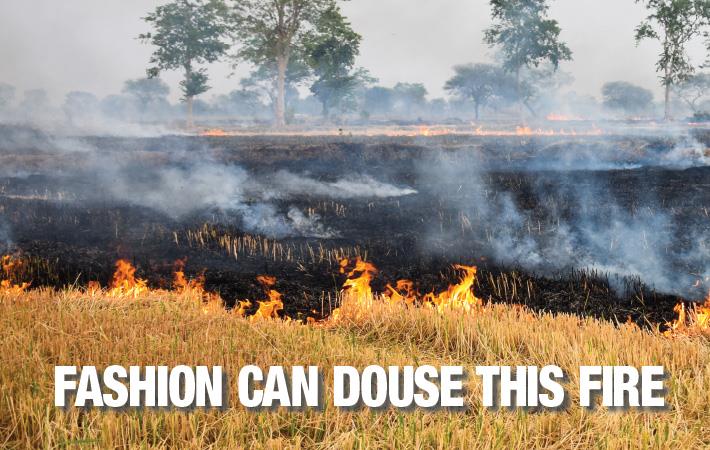In October-November this year, pollution levels in Delhi-NCR reached alarming proportions with stubble burning by farmers in Punjab and Haryana being one of the prime reasons for the hazardous haze that hung around the region for weeks. The textiles industry has a solution.
For one week the air pollution levels in Delhi and the NCR (National Capital Region) shot through the roof, forcing authorities to declare a public health emergency. Schools and colleges remained closed as Delhi-NCR choked under the dense fumes puffing in from neighbouring Punjab and Haryana. The capital region had its sources of pollution.#
By Subir Ghosh
For one week the air pollution levels in Delhi and the NCR (National Capital Region) shot through the roof, forcing authorities to declare a public health emergency. Schools and colleges remained closed as Delhi-NCR choked under the dense fumes puffing in from neighbouring Punjab and Haryana. The capital region had its sources of pollution.#
For one week the air pollution levels in Delhi and the NCR (National Capital Region) shot through the roof, forcing authorities to declare a public health emergency. Schools and colleges remained closed as Delhi-NCR choked under the dense fumes puffing in from neighbouring Punjab and Haryana. The capital region had its sources of pollution (from vehicular emissions to pollution caused by power plants), but the stubble burning in the two Northern states came as the last straw.
For one week the air pollution levels in Delhi and the NCR (National Capital Region) shot through the roof, forcing authorities to declare a public health emergency. Schools and colleges remained closed as Delhi-NCR choked under the dense fumes puffing in from neighbouring Punjab and Haryana. The capital region had its sources of pollution.#
Even though, at its peak, stubble burning accounted for only 35 per cent share of the hazardous haze, it were the farmers of the two states who became the villains of the entire piece. Social media went into a tizzy and furiously-contested television debates kept flogging a dead horse—something that they had done last year as well. As also in the previous years. Worse, there had been early warnings in September itself about farm fires being recorded in the two states.
For one week the air pollution levels in Delhi and the NCR (National Capital Region) shot through the roof, forcing authorities to declare a public health emergency. Schools and colleges remained closed as Delhi-NCR choked under the dense fumes puffing in from neighbouring Punjab and Haryana. The capital region had its sources of pollution.#
During a crisis it is easy to play the blame game. The point, however, is that the problem has existed for a while now, and nothing has been done about it. The same set of solutions (particularly those related to stubble burning) that were thrown around last year were discussed this year as well. All direct stakeholders have a role to play, but then also do some others who apparently do not come across as stakeholders. The textiles industry, for instance. Yes, it can indeed play a role.
For one week the air pollution levels in Delhi and the NCR (National Capital Region) shot through the roof, forcing authorities to declare a public health emergency. Schools and colleges remained closed as Delhi-NCR choked under the dense fumes puffing in from neighbouring Punjab and Haryana. The capital region had its sources of pollution.#
Take this emphatic statement: “Agricultural waste which is burned in fields across states around Delhi would be enough to replace over half of global cotton production by building bio-refineries and textile fibre production plants to make efficient use of biomass.” The words come from the head of the Bio2X programme at Fortum India, Faizur Rehman.
For one week the air pollution levels in Delhi and the NCR (National Capital Region) shot through the roof, forcing authorities to declare a public health emergency. Schools and colleges remained closed as Delhi-NCR choked under the dense fumes puffing in from neighbouring Punjab and Haryana. The capital region had its sources of pollution.#
Read the complete article in December 2019 issue of Fibre2Fashion.
For one week the air pollution levels in Delhi and the NCR (National Capital Region) shot through the roof, forcing authorities to declare a public health emergency. Schools and colleges remained closed as Delhi-NCR choked under the dense fumes puffing in from neighbouring Punjab and Haryana. The capital region had its sources of pollution.#
Fibre2Fashion News Desk (RKS)
